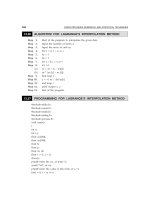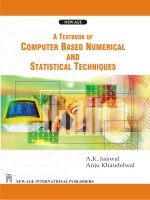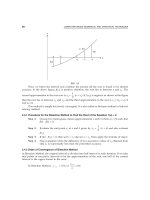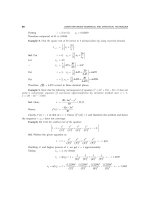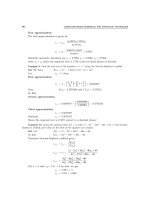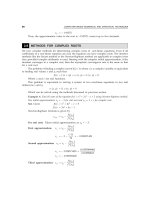A textbook of Computer Based Numerical and Statiscal Techniques part 15 doc
Bạn đang xem bản rút gọn của tài liệu. Xem và tải ngay bản đầy đủ của tài liệu tại đây (104.5 KB, 10 trang )
126
COMPUTER BASED NUMERICAL AND STATISTICAL TECHNIQUES
Similarly, ∆
n
1
x
=
()()() ()
()()()
−−− −
++ +
1 2 3
1 2
n
xx x x n
=
()
()()()
1!
12
n
n
xx x x n
−
++ +
(2) Similarly, ∆ (ab
cx
)= a ∆ b
cx
= a{b
c(x + 1)
– b
cx
}
= a{b
cx
b
c
– b
cx
} = a(b
c
–1)b
cx
.
2
()
cx
ab
∆
=
{}
() (1)
cx
ccx
ab a b b
∆∆ = ∆ −
=
2
(1) (1)
ccxccx
ab b ab b
−∆ = −
Proceeding in the same manner, we get
()
ncx
ab
∆
= a(b
c
– 1)
n
b
cx
.
Example 29. If p, q, r and s be the successive entries corresponding to equidistant arguments
in a table, show that when third differences are taken into account, the entry corresponding to the argument
half way between the arguments of q and r is
+
1
AB
24
, where A is the arithmetic mean of q, r and B is
the arithmetic mean of 3q – 2p – s and 3r – 2s – p.
Sol. On taking h being the interval of differencing the difference table is as:
∆∆ ∆
−
+−+
−−+−
+−+
−
+
23
2
33
22
3
xx x x
xu u u u
ap
qp
ah q r qp
rq s r qp
ahr srq
sr
ahs
The argument half way between the arguments of q and r is
1
2
(a + h + a + 2h) i.e.,
3
2
ah+
.
Hence, the required entry is given by,
u
a+(3/2)h
= E
3/2
u
a
= (1 + ∆)
3/2
u
a
=
+∆+ ∆+ − ∆
23
3311 3111
1
2222! 2223!
a
u
,
(Higher order differences being neglected).
Therefore u
a+(3/2)h
=
23
33 1
28 16
aa a a
uu u u
+∆ +∆ − ∆
=
33 1
()(2) (33)
28 16
pqp rqp srqp+−+−+− −+−
CALCULUS OF FINITE DIFFERENCES
127
=
331 333 33 1
1
2 8 16 2 4 16 8 16 16
pqrs
−++ + −− + + −
=
1991
16 16 16 16
pqrs−++−
=
1111
()
16 16 2 16
pqr s
−++ +−
=
11
() ( )
216
qr qrps++ +−−
(1)
Again A = arithmetic mean of q and r =
1
()
2
qr+
B = Arithmetic mean of 3q – 2p – s and 3r – 2s – p is
=
[]
()
13
32 32
22
q ps r sp qrsp
−−+−−= +−−
.
∴
1
24
AB+
=
1
().
216
qr
qrsp
+
++−−
Substituting this value in (1), we get u
a+(3/2)h
= A +
1
24
B.
Example 30. Given u
0
, u
1
, u
2
, u
3
, u
4
and u
5
. Assuming that, fifth order differences to be constant.
Show that:
−+ −
=+
1
2
2
1 25(c b) 3(a c)
uc
2 256
. where a = u
0
+ u
5
, b = u
1
+ u
4
, c = u
2
+ u
3
Sol. L.H.S.
1
2
2
u
= E
5/2
u
0
= (1 + ∆)
5/2
u
0
=
25
0
55 55555
.1 1234
5
22 22222
1
22! 5!
u
−−−−−
+∆+ ∆+ + ∆
=
23 4 5
00 0 0 0 0
515 5 5 3
2 8 16 128 256
uu u u u u+∆ + ∆ + ∆ − ∆ + ∆
=
010 210 3210
515 5
( ) ( 2 ) ( 3 3 )
28 16
u uu uuu uuuu+−+ −++ −+−+
543210
3
( 5 10 10 5 )
256
uu u uuu+−+−+−
128
COMPUTER BASED NUMERICAL AND STATISTICAL TECHNIQUES
=
05 14 23
32575
()()()
256 256 128
uu uu uu+− ++ +
=
32575
256 256 128
abc−+
=
325111
256 256 2 128
ab c
−++
=
3( ) 25( )
2 256
cac cb−+ −
+
(R.H.S.)
Example 31. Given:
u
0
+ u
8
= 1.9243, u
1
+ u
7
= 1.9590, u
2
+ u
6
= 1.9823, u
3
+ u
5
= 1.9956. Find u
4
.
Sol. Since 8 entries are given, therefore we have ∆
8
u
0
= 0
i.e. (E – 1)
8
u
0
= 0
i.e. (E
8
–
8
C
1
E
7
+
8
C
2
E
6
–
8
C
3
E
5
+
8
C
4
E
4
–
8
C
5
E
3
+
8
C
6
E
2
–
8
C
7
E
1
+ 1)u
0
= 0
i.e. (E
8
– 8E
7
+ 28E
6
– 56E
5
+ 70E
4
– 56E
3
+ 28E
2
– 8E + 1)u
0
= 0
i.e. u
8
– 8u
7
+ 28u
6
– 56u
5
+ 70u
4
– 56u
3
+ 28u
2
– 8u
1
+ u
0
= 0
i.e. (u
8
+ u
0
) – 8(u
7
+ u
1
) + 28(u
6
+ u
2
) – 56(u
5
+ u
3
) + 70u
4
= 0
On putting the given values, we get
1.9243 – 8(1.9590) + 28(1.9823) – 56 (1.9956) + 70u
4
= 0
or –69.9969 + 70u
4
= 0
or u
4
= 0.9999557.
Example 32. Sum the following series 1
3
+ 2
3
+ 3
3
+ + n
3
using the calculus of finite
differences.
Sol. Let 1
3
= u
0
, 2
3
= u
1
, 3
3
= u
2
, , u
3
= u
n–1
. Therefore sum is given by
S = u
0
+ u
1
+ u
2
+ + u
n–1
= (1 + E + E
2
+ E
3
+ + E
n–1
)u
0
=
1
1
n
E
E
−
−
u
0
=
()
11
n
+∆ −
∆
u
0
=
1
∆
() ()()
23
112
1 1
2! 3!
n
nn nn n
n
−−−
+∆+ ∆+ ∆+ +∆−
u
0
=
()
()
()
2
00
12
1
2! 3!
nn n
nn
nu u
−−
−
+∆+ ∆
+
We know ∆u
0
= u
1
– u
0
= 2
3
– 1
3
= 7.
∆
2
u
0
= u
2
– 2u
1
+ u
0
= 3
3
–2(2)
3
+ 1
3
= 12.
Similarly we have obtained
∆
3
u
0
= 6 and
∆
4
u
0,
∆
5
u
0
, are all zero as
u
r
=
r
3
is a polynomial
of third degree.
CALCULUS OF FINITE DIFFERENCES
129
∴
S = n +
()
1
2!
nn
−
(7) +
()()
12
6
nn n
−−
12 +
()()()
123
24
nn n n
−−−
(6)
=
2
4
n
(n
2
+ 2n + 1) =
()
2
1
2
nn
+
Example 33. Prove that:
∞∞
==
∆∆
=+−+−
∑∑
2
2x
x
x0 x0
11
uu1
2424
u
0
.
Sol. Taking right hand side of the given expression
=
2
0
11
1
2424
x
x
u
∞
=
∆∆
+−+−
∑
u
0
=
1
2
(u
0
+ u
1
+ u
2
+ u
3
+ ) +
1
4
1
1
2
−
∆
+
u
0
=
1
2
(u
0
+ Eu
0
++ E
2
u
0
+ E
3
u
0
+ ) +
1
4
1
1
2
−
∆
+
u
0
=
1
2
(1 + E + E
2
+ E
3
+ )u
0
+
1
4
1
1
2
−
∆
+
u
0
=
1
2
(1 – E)
–1
u
0
+
1
2
(2 +
∆
)
–1
u
0
=
1
2
(1 – E)
–1
u
0
+
1
2
(1 +
∆
)
–1
u
0
=
1
2
[(1 – E)
–1
+ (1 + E)
–1
]u
0
=
1
2
. 2 [1 + E
2
+ E
4
+ E
6
+ ]u
0
= u
0
+ u
2
+ u
4
+ u
6
+
=
2
0
x
x
u
∞
=
∑
= L.H.S.
Example 34. Given that u
0
= 3, u
1
= 12, u
2
= 81, u
3
= 200, u
4
= 100, u
5
= 8. Find the value of
∆
5
u
0
.
Sol. We know
∆
= E – 1, therefore,
5
0
u∆
=
(E –1)
5
u
0
= (E
5
– 5E
4
+ 10E
3
– 10E
2
+ 5E – 1)u
0
=
u
5
– 5u
4
+ 10u
3
– 10u
2
+ 5u
1
– u
0
= 8 – 500 + 2000 – 810 + 60 – 3
= 755.
130
COMPUTER BASED NUMERICAL AND STATISTICAL TECHNIQUES
PROBLEM SET 3.1
1. Form the forward difference table for given set of data:
X:10203040
Y: 1.1 2.0 4.4 7.9
2. Construct the difference table for the given data and hence evaluate
3
(2)
f∆
.
X:01234
Y: 1.0 1.5 2.2 3.1 4.6 [Ans. 0.4]
3. Find the value of E
2
x
2
when the values of x vary by a constant increment of 2.
[Ans. x
2
+ 8x + 16]
4. Evaluate E
n
e
x
when interval of differencing is [Ans. E
n
e
x
= e
x+nh
]
5. Evaluate ∆
3
(1 –x) (1–2x) (1–3x) ; the interval of differencing being unity.
[Ans.
3
() 36
fx∆=−
]
6. If f(x) = exp (ax), evaluate
()
n
fx
∆
[Ans.
(1)
nax ah nax
ee e
∆=−
]
7. Evaluate
2
3
x
E
∆
[Ans. 6x]
8. Find the value of
24
2
22
(1)
xx
aa
a
+
∆
−
[Ans.
2224
(1)
xx
aa a
++
]
9. Evaluate:
(a)
cot 2
x
∆
[Ans. –Cosec 2
x+1
]
(b) ∆+sin ( )ha bx [Ans.
++2sin cos ( )
22
bb
hhabx
]
(c)
tan ax∆
[Ans.
sin
cos cos ( 1)
a
ax a x
+
]
10. Prove that:
(a)
1/2
1
2
E =µ= δ
(b)
1/2 1/2 1
()
EE E
−−
δ+ =∆+∆
(c)
1/2 1/2
(1 ) (1 )
−−
δ=∇ −∇ =∆ +∆
(d)
1/2 1/2
EE
−
δ=∆ =∇
(e)
2
∇∆ = ∆∇ = δ
(f)
11 1
1
EE E
−− −
∇=∆ = ∆= −
11. Show that:
(a)
sin
cot( )
sin( ) sin( )
b
abx
abx abbx
−
∆+=
+++
(b)
(( )
sin( ) (2sin ) sin(
22
n
n
bnb
abx abx
+π
∆+= ++
(c)
()
cos( ) (2 sin ) cos(
22
n
n
bnb
abx abx
+π
∆+= ++
CALCULUS OF FINITE DIFFERENCES
131
12. What is the difference between
2
E
∆
u
x
and
2
2
x
x
u
Eu
∆
. If u
x
= x
3
and the interval of
differencing is unity. Find out the expression for both. [Ans. 6h
2
(3x – h),
23
3
66
(2)
xh h
xh
+
+
]
13. If f(x) = e
ax
, show that f(0) and its leading differences form a geometrical progression.
14. A third degree polynomial passes through the points (0, –1), (1, 1), (2, 1) and (3, 2). Find
the polynomial. [Ans.
32
1
(3166)
6
xx x−+−+
]
15. Prove that ∆ sin
–1
x =
22
[( 1) 1 1 ( 1) ]
xxxx
+−−−+
.
3.5 FUNDAMENTAL THEOREM ON DIFFERENCES OF POLYNOMIAL
Statement: If f(x) be the nth degree polynomial in x, then the n
th
difference of f(x) is constant and
∆
n+1
f(x) and all higher differences are zero when the values of the independent variables are at
equal interval.
Proof: Consider the polynomial f(x) = a
0
+ a
1
x + a
2
x
2
+ + a
n
x
n
(1)
Where n is a positive integer and a
0
, a
1
, a
2
, a
n
are constants.
We know ∆f(x)= f(x + h) – f(x).
On applying the operator ∆ on equation (1), we get
∆f(x)= ∆(a
0
+ a
1
x + a
2
x
2
+ + a
n
x
n
)
⇒ f(x + h) – f(x)= [a
0
+ a
1
(x + h) + a
2
(x + h)
2
+ + a
n
(x + h)
n
]
–[a
0
+ a
1
x + a
2
x
2
+ +a
n
x
n
]
22 33
12 3
[( ) ] [( ) ] [( ) ]
nn
n
ahaxhxaxhx axhx
⇒+ +−+ +−+ + +−
⇒ a
1
b + a
2
[
2
C
1
xh + h
2
] + a
3
[
1
2
323 23 1 2
12 1
] [ ]
n
nn nCx nn
nn
Cxh Cxh h a Cx h h Ch
−
−
++++ + +
221
12 3 1
nn
nn
bbxbx bx nahx
−−
−
⇒+ + + + +
(2)
where b
1
, b
2
, b
n–1
are constant coefficients.
According to equation (2), we have the first difference of equation (1) is again a polynomial
of degree n – 1.
From this we say that ∆f(x) is one degree less than the degree of original polynomial.
Again, on taking a difference of equation (2) i.e. second difference of equation (1), we get
2222
23 4
( ) ( 1)
n
n
fx C Cx Cx nn hax
−
∆=++++−
…(3)
This is a polynomial of degree n – 2.
Thus, on continuing this process up to nth difference we get a polynomial of degree zero.
Such that:
()
n
fx
∆
=
( 1)( 2) 1.
nnn
n
nn n h ax
−
−−
=
0
!
n
n
nhax
=
!
n
n
nha
132
COMPUTER BASED NUMERICAL AND STATISTICAL TECHNIQUES
Hence, we have nth difference of the polynomial is constant and so all higher differences are
each zero. i.e.
12
() () 0
nn
fx fx
++
∆=∆==
3.6 ESTIMATION OF ERROR BY DIFFERENCE TABLE
Let y
0
, y
1
, y
2
, y
n
be the exact values of a function y = f(x) corresponding to arguments
x
0
, x
1
, x
2
, , x
n
. Now to determine error in such a case and to correct the functional values,
let an error δ is made in entering the value of y
3
in the table so that erroneous value of y
3
is
y
3
+ δ.
2
00
11 0
2
22 1 0
2
33 2 1
2
44 3 2
2
55 4 3
4
66 5
2
xy y y
xy
xy y
xy y y
xy y y
xy y y
xy y y
y
xy y
∆∆
∆
∆∆
+δ ∆ +δ ∆ +δ
∆−δ ∆ −δ
∆∆+δ
∆
∆
From the above difference table we noted that:
1. The error in column y affects two entries in column ∆y, three entries in column ∆
2
y and
so on. i.e. the error spreads in triangular form.
2. The error increases with the order of differences.
3. The coefficients of δ’s are binomial coefficients with alternative signs +, –,
4. In various difference columns of the above table the algebraic sum of the errors is zero.,
5. The errors in the column ∆
i
y are given by the coefficients of the binomial expansion
(1 –δ)
i
.
6. In even differences columns of ∆
2
y, ∆
4
y, , the maximum error occurs in a horizontal line
in which incorrct value of y lies.
7. In odd difference columns of ∆
1
y, ∆
3
y, , the maximum error lies in the two middle
terms and the incorrect value of y lies between these two middle terms.
Example 1. Find the error and correct the wrong figure in the following functional values:
Sol.
1234567
2 5 10 18 26 37 50
x
y
CALCULUS OF FINITE DIFFERENCES
133
∆∆ ∆
−
−
23
12
3
25 2
51
310 3
83
418 0
83
526 3
11 1
637 2
13
750
xy y y y
Here the sum of all the third differences is zero and the adjacent values –3, 3 are equal in
magnitude. Also horizontal line between –3 and 3 points out the incorrect functional value 18.
Therefore coefficient of first middle term on expansion of (1 – p)
3
= –3
⇒ –3e = –3 ⇒ e = 1
∴ Correct functional value = 18 – 1 = 17.
Example 2. Find and correct by means of differences the error in the following table:
20736, 28561, 38416, 50625, 65540, 83521, 104976, 130321, 160000
Sol. For the given data we form the following difference table:
∆∆∆∆∆
−
−
2345
20736
7825
28561 2030
9855 324
38416 2354 28
12209 352 20
50625 2706 8
14915 360 40
65540 3066 48
17981 408 40
83521 3474 8
21455 416 20
104976 3890 28
25345 444
130321 4334
29679
160000
y y y yyy
→
←
134
COMPUTER BASED NUMERICAL AND STATISTICAL TECHNIQUES
From this table we have the third differences are quite iregular and the irregularity starts
around the horizontal line corresponding to the value y = 65540.
Since the algebraic sum of the fifth differences is 0, therefore –5ε = –20 ⇒ ε = 4.
Therefore the true value of y
5
= 65540 – 4 = 65536.
Example 3. Locate the error in following entries and correct it.
1.203, 1.424, 1.681, 1.992, 2.379, 2.848, 3.429, 4.136
Sol. Difference table for given data is as follows:
∆∆ ∆ ∆
−
−
3 3 32 33 34
10 10 10 10 10
1203
221
1424 36
257 18
1681 54 4
311 22
1992 76 16
387 6
2379 82 24
469 30
2848 112 16
581 14
3429 126
707
4136
yy y y y
Sum of all values in column of fourth difference is –0.004 which is very small as compared
to sum of values in other columns.
∴∆
4
y = 0
Errors in this column are e, –4e, 6e, –4e and e.
Term of Maximum value = 24 ⇒ 6e = 24 ⇒ e = 4.
Error lies in 2379.
Hence, required correct entry = 2379 – 4 = 2375.
Hence, correct value = 2.375
→
←
CALCULUS OF FINITE DIFFERENCES
135
Example 4. One number in the following is misprint. Correct it.
1 2 4 8 16 26 42 64 93.
Sol. Difference table for given data it as follows:
∆∆∆∆∆
−
−
−
−
−
2345
11
1
22 1
21
34 2 1
42 5
48 4 4
8210
516 2 6
10 4 10
626 6 4
16 0 5
742 6 1
22 1
864 7
29
993
xyyyyyy
In the above table, the fourth difference column have algebraic sum of all the values is 0.
The middle term of this difference column is 6.
∴ 6e = 6 or e = 1.
∴ Correct value is given by 16 – 1 = 15.
Example 5. Locate the error in the following table:
1234567891011
1.0000 1.5191 2.0736 2.6611 3.2816 3.9375 4.6363 5.3771 6.1776 7.0471 8.0000
x
y
